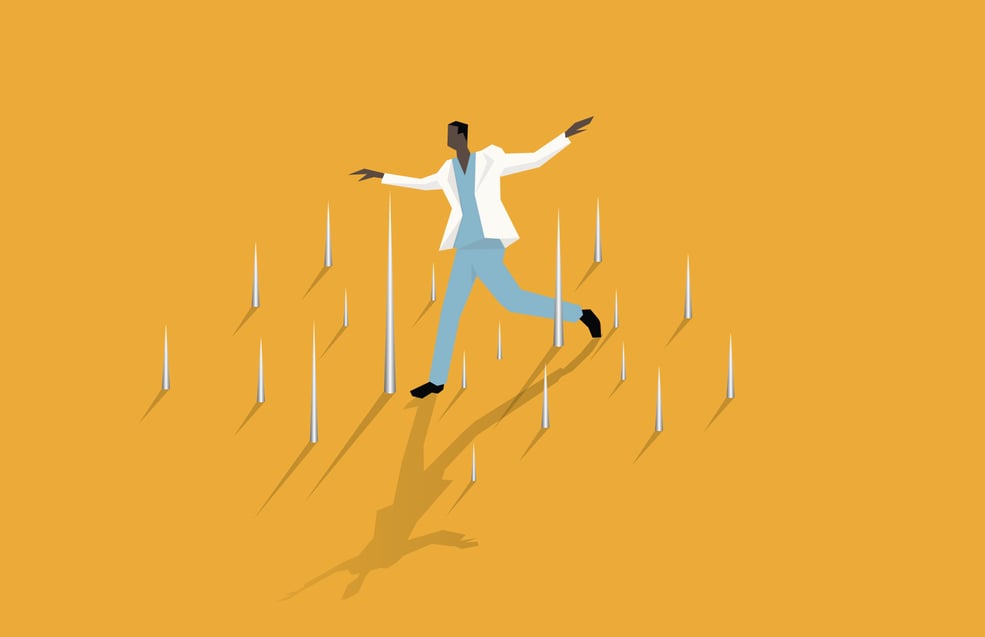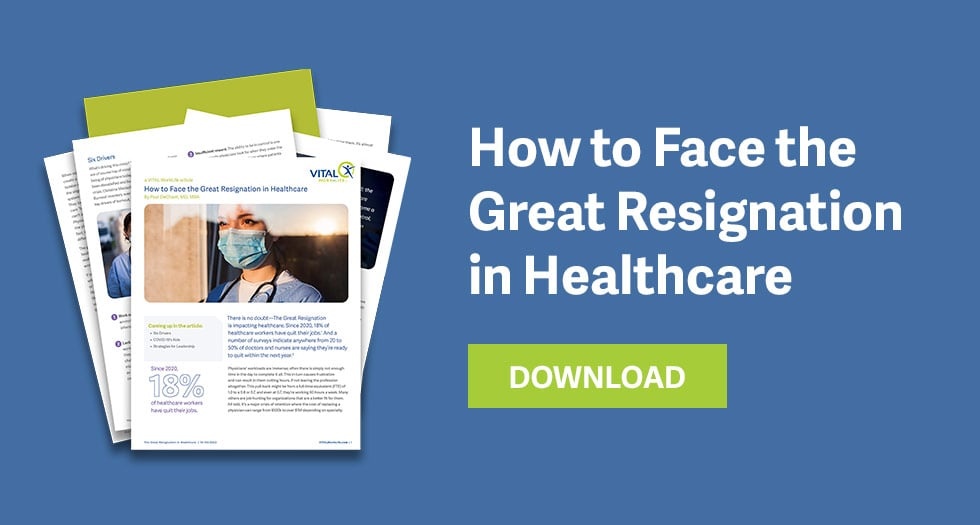It was a tsunami of struggle for the Prime Health System.*
After struggling through the worst of COVID with a swelling patient population, PPE in short supply, fear of contagion among the staff, a treacherous and still-little-known disease to contend with, everyone at Prime looked for a respite—a respite that didn’t come. As vaccination spread there were fewer pandemic patients, but a rush of people who had put off dealing with other issues. Above all, there was the Great Resignation: exhausted physicians and healthcare workers cutting back hours, resigning, even leaving medicine altogether. Prime’s hospitals, in particular, were critically short-staffed.

Nurse Marianna Obispo, whose ICU burden had more than doubled in the pandemic, found that as the number of her patients went down somewhat, so did the number of her nurse colleagues. From caring for the typical one or two patients, she went to caring for four, sometimes five.
She was tapped out. It wasn’t just the workload, the accumulated stress and relentless fatigue; it was how her exhaustion was affecting her family. Her husband, Frank, was the owner of three franchise restaurants in the city and he was struggling with resignations and short-staffing as well—so he could sympathize with Marianna’s experience. Plus the couple’s daughter, Kyra, was having a hard time in high school. Returning to live classes after nearly two years of remote learning, her grades were slipping, she seemed permanently unhappy and she had grown even more uncommunicative. With both Frank and Marianna putting in punishingly long hours, Kyra had become more or less a latchkey kid; many days Marianna didn’t see her daughter at all except to look in on her as she slept. The guilt about not being present to support her daughter’s needs was ever-present and weighed heavily on her.
Marianna’s 70-year-old mother, Imelda, lived with the family too, and her health issues of high blood pressure, diabetes and shortness of breath concerned Marianna. Her very identity as a nurse made the worries worse—what if she missed a sign of trouble simply because she was absent or too tired to notice? She wouldn’t be able to forgive herself.
During the little time she had to herself, she found herself wondering if her three decades in nursing might be enough—or if joining a pool, in which she could set her own hours and turn down work she didn’t want, might be the answer. She longed to share her frustrations and fears with colleagues, but they all seemed as stressed and overburdened as she was, and she didn’t want to presume.
Dr. Karen Orlovsky had already made her decision. She was getting out. Not out of medicine, no, probably not out of medicine altogether, but out of the trap she felt she was in.
She had welcomed the toughness of medical training—she was an athlete with three college letters in track and field and loved leaning into a physical, emotional and mental challenge. She learned to keep going without sleep or bathroom breaks or healthy meals. She believed in continuity of care, in following patients through the course of their treatments, day and night, night and day.
But she also believed in intensity of care—and that was the problem. The ten years she had spent practicing medicine before COVID were a gradual awakening to the fact that actually caring for patients was a smaller part of her job than she had anticipated. Sometimes, in the second or third hour of a struggle with the protocols of the EHR on her laptop she felt that she was a medical coder with a sideline in seeing patients. When she was seeing them, it always seemed like the clock was ticking. But it wasn’t just her, everybody else in the larger Cafferty Avenue Clinic seemed just as time-pressed as she was.
The pandemic was a nightmare, of course, and it made everything worse. But in a way, the aftermath was even harder for Dr. Orlovsky to deal with. Drafted to join the Prime Health Methodist Hospital staff during COVID, she stayed on as the hospital’s staffing problems failed to abate. The overwork, the time pressure and the relentless data entry didn’t let up. It wasn’t long before Dr. Orlovsky began having a sinking feeling that they never really would, pandemic or no pandemic. Was this reality what she had entered medicine for? Was she giving her best? What was her best? It seemed lost as the hours galloped by.
Yes, somehow, she would get out.
Dev Srinivasan, Prime Health’s CEO, was putting band-aids on staffing hemorrhages as the Great Resignation rolled on. The locum and pool practitioners he was hiring to fill the most alarming staffing gaps were expensive. Schedule adjustments—a euphemism for giving most physicians longer shifts—made him nervous about quality of care. And yes, patient satisfaction scores in many of the clinics and the departments of the hospitals were on a definite downward trajectory. He was worried. His board was worried.
He needed to stem the tide of resignations, if he could, and he needed to recruit. But what could he do? He couldn’t force people to stay at their posts, and he couldn’t reach into med schools and post-doc fellowship programs and yank physicians out for Prime.
One piece of good news was sticking with him. The respiratory-care department at Prime Health Longacre Hospital, which had its own set of challenges during the pandemic, had only lost a handful of physicians since mid-2021. Harry Mead, the Longacre medical director, told Srinivasan the unit in collaboration with the hospital’s Physician Well Being Resource program, had set up an informal system of get-togethers, what they call Gripe Sessions (GS’s) and had in turn given birth to peer-to-peer relationships of support. Dr. A committed to supporting Dr. B, and took it upon themself to be alert to signs of super-stress or incipient burnout.
“They just set it up with the resources they had access to through our system’s well being resource partner. They decided they weren’t going to wait for a go-ahead from above,” said Dr. Mead, rather deliberately.
Okay, thought Srinivasan. Point taken. When I think of physician well being, I think: money and time we don’t have, not right now. We’ll do it when things cool down.
But when will things cool down? Maybe never.
The story continues in part three, when we see how Prime Health faces the Great Resignation head-on and fosters a culture of care and well being amongst their staff.
For more on The Great Resignation in Healthcare and how to face it head on, read our article, “Confronting the Great Resignation in Healthcare with Well Being Strategies.”
The story continues in part three, when we see how Prime Health faces the Great Resignation head-on and fosters a culture of care and well being amongst their staff.
For more on The Great Resignation in Healthcare and how to face it head on, read our article How to Face the Great Resignation in Healthcare.
*Prime Health is a fictional health system. None of the names, locations or scenarios are based on specific real life events, but are a fictionalized version of what has been generally experienced by many individuals and organizations.



